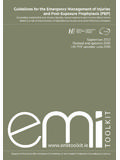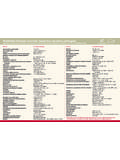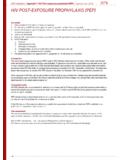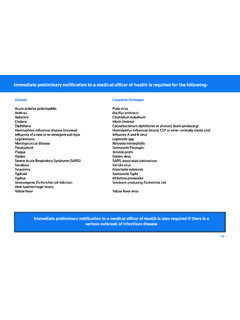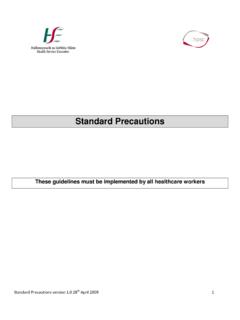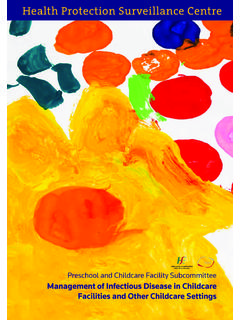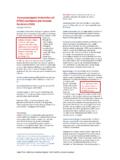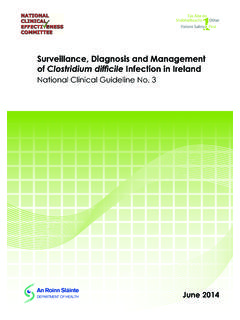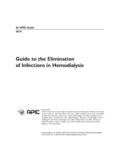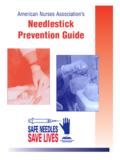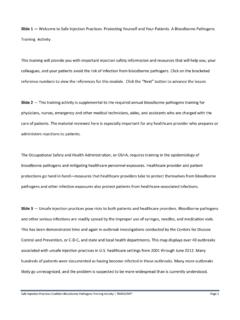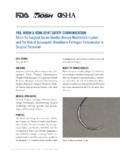Transcription of toolkit EMI Guidelines - Appendix 23 Hepatitis C virus ...
1 toolkit -77- Hepatitis c virus : epidemiology and transmission risksHepatitis C infection is caused by an RNA virus that was first identified in Chronic Hepatitis C infection is a major cause of chronic liver disease and death throughout the Approximately 3% of the world s population is infected with Hepatitis c virus (HCV).3 Six distinct but related genotypes and multiple subtypes have been , 4 in western Europe genotypes 1a and 1b are most common, followed by genotypes 3 and is transmitted by blood and now occurs primarily through injecting drug use, and less frequently through sex with an infected partner, occupational exposure, and maternal-foetal transmission. in some cases no risk factors can be , 5 transfusion-related HCV infection is rare now since the introduction of routine screening of blood for HCV antibodies in the early informationin general, acute HCV infection is relatively mild, with only 20-30% of infected persons developing symptoms or clinically evident acute infection.
2 In most persons who become infected with HCV, viraemia persists. Antibody to HCV (anti-HCV) is present in acute, chronic and resolved infection. HCV RNA/HCV Ag is an indication of HCV HCV infection is marked by persistence of HCV RNA for at least 6 months after onset of infection. Spontaneous resolution after 6 or 12 months of infection is unusual. Between 55 and 85% of those infected develop chronic Chronically infected people are at risk for progressive liver disease characterised by hepatocellular inflammation, hepatic fibrosis, cirrhosis and hepatocellular carcinoma (HCC). these complications develop only in a proportion of patients and only after many years or decades of infection. it has been estimated that up to 20% of chronically infected individuals will develop cirrhosis of the liver over a 20 to 25 year period, and that, of patients with cirrhosis, approximately 3% to 4% will develop HCC per year.
3 Factors that have been shown to be associated with progression of liver fibrosis include older age at infection, male gender, genetic factors, metabolic factors (steatosis, diabetes and obesity), co-infection with human immunodeficiency virus (HiV) or Hepatitis B, duration of infection, and alcohol effective all-oral treatment with direct-acting antivirals is now available in ireland. this eradicates the virus in over 90% of of HCV infection in Ireland, Europe and the worldIrelandA previous study has estimated that the prevalence of chronic HCV infection in ireland is 8. this study took undiagnosed cases into account. More recent estimates of levels of undiagnosed Hepatitis C in ireland indicate the overall prevalence of Hepatitis C in ireland is more likely to be between and (23,000 to 32,000).
4 9 this is similar to other countries in northern Europe and in line with the WHo estimate of <1%. However, it is more prevalent in certain sub-groups of the population, in particular people who inject drugs (PWiD) and prisoners. HCV may also be more prevalent in immigrants to ireland from endemic donorsof 313,019 first time blood donors tested by the iBtS between 1997 and 2015, 48 ( ) were found to be HCVpositive. (Personal communication, Dr Joan o Riordan, iBtS, July 2016).Asylum seekersScreening of asylum seekers in the HSE eastern region 1999-2003 found a prevalence of anti-HCV of reception centre in HSE East, reported that 1% of those tested under the voluntary health screening programme, between 2004 and 2012, were positive for chronic HCV and people who inject drugsStudies of PWiD in prisons and PWiD attending methadone clinics, specialist addiction treatment centres and GPs have estimated the HCV prevalence in this population to be between 62% and 81%.
5 12A national cross sectional survey of irish prisoners in 1998 showed a prevalence of anti-HCV of 37% of all prisoners, and of in prisoners who were prisoners who inject recently, a 2011 prison study found that 54% of prisoners with a history of injecting heroin were anti-HCV positive and of prisoners with a history of injecting any drugs were anti-HCV Guidelines - Appendix 23 Hepatitis c virus : epidemiology and transmission risks (updated May 2016)toolkitTrends in HCV in IrelandHepatitis C became a notifiable disease in ireland in 2004. Between 2004 and 2015, 13,478 cases were notified. the highest annual number of notifications was in 2007 (n=1539). there has been a significant decrease in recent years and 678 cases were notified in 2015. two thirds of cases were male and most were young to middle aged adults (median age: 34 years, mean age: years).
6 Where risk factor information was available, over 80% of cases between 2007 and 2015, were among people who inject in Europein Europe, HCV infection shows a significant increasing trend in reported numbers. Every year there are 27,000 to 29,000 newly diagnosed cases in the recent systematic literature review of HCV prevalence in Europe, based on information from 14 countries, reported a prevalence range of the prevalence is higher in the southern part of Europe. Countries with high prevalence (more than 2%) include italy, Romania and Spain. Medium prevalence was observed in Bulgaria, France, Greece, and Poland. Countries with low prevalence (less than 1%) include Belgium, Germany, the Netherlands, Sweden, and the United most severely affected population groups are people who inject drugs, haemodialysis patients, persons living with HiV, inmates, and immigrants from high-endemic regions.
7 Reported numbers are likely to reflect the current testing and screening practices in countries rather than the real incidence of infection. the reported number is an underestimate of the real occurrence of HCV due to the asymptomatic nature of the of HCV prevalence in different population groups by country in Europe are available in the ECDC technical HCV distributionthe estimated global prevalence of HCV is 2-3% .17, 18 Countries with the highest reported prevalence rates are located in Africa and Asia. China has a reported seroprevalence of one community-based survey in india reported an overall rate of indonesia s rate is in serosurveys of voluntary blood donors. the seroprevalence in Pakistan is reported to range from to Egypt has the highest reported seroprevalence rate, 22%.
8 17 Areas of lower prevalence include North America, northern and western Europe, and predominant source of new HCV infections in developed countries over the past few decades is injecting drug use. in developing countries, unsafe therapeutic injections and transfusions are likely to be the major modes of Anti-HCV prevalence in PWiD globally varies greatly, from to (See map, Appendix 24).Transmission risksNeedlestick injuriesthere is a wide range of reported estimates for the risk of transmission of HCV after a needlestick or sharps injury from a source patient between 0 and 10%.20-22 the estimated risk from a needlestick injury from a source with detectable HCV RNA is the risk of developing HCV is greater after an injury with a hollow-bore needle21, or deep injuries24, compared with other injuries.
9 Also, one study showed an 11-fold increase in transmission of HCV from source patients with viral load >6 log10 copies/ml, compared with source patients with viral load 4 log10 copies/ml following percutaneous the risk of transmission is also influenced by whether the source is co-infected with HiV (see section below).in cold temperatures, HCV can survive in syringes for many days in laboratory the clinical implications of this are unknown, but the risk of becoming infected with HCV from an abandoned syringe depends on the prevalence of HCV in the local community. there are case reports of HCV transmission from needlestick injuries in the community26, but as the exact incidence of injuries in the community is not known, the risk of transmission from such injuries cannot be accurately percutaneous exposuresthe risk of acquiring HCV during an operation performed by an infected surgeon is reported to be between 0 and 27,28,29 in general the risk of contracting HCV following an injury from an unknown source is in the workplace, other than in the healthcare setting, such as razors and meat slicers have also been implicated in the transmission of , 32there is an increased incidence of HCV in those who have a tattoo, with a pooled odds ratio of (95% Ci ).
10 Large tattoos, and those received in non-professional locations are associated with the greatest exposuresSeveral case reports have been published describing the transmission of HCV following a splash of blood into the eye of the ,35 Also, transmission of HCV has occurred following splashes of infected blood onto broken the exact risk associated with these exposures is Guidelines - Appendix 23 Hepatitis c virus : epidemiology and transmission risks (updated May 2016)toolkitExposure to saliva (including injuries caused by human bites)HCV RNA has been demonstrated in , 38 Case reports describe transmission of HCV following human bites, but precise details of the nature of the bites, and whether blood was present in the mouth of the biter, or whether skin was broken at the time of the bite, are not inoculation with saliva has caused transmission of the virus in experimental , 41 Studies in dentists indicate a low incidence of nosocomial transmission of it is also thought, however, that HCV can be transmitted via sharing a toothbrush with an index , 43 Sexual exposuresin general, transmission of HCV via sexual contact is inefficient in stable monogamous heterosexual there is evidence, however.
